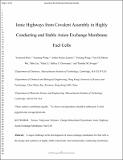| dc.contributor.author | Kim, Yoonseob | |
| dc.contributor.author | Wang, Yanming | |
| dc.contributor.author | France-Lanord, Arthur | |
| dc.contributor.author | Wang, Yichong | |
| dc.contributor.author | Wu, You-Chi Mason | |
| dc.contributor.author | Lin, Sibo | |
| dc.contributor.author | Li, Yifan | |
| dc.contributor.author | Grossman, Jeffrey C. | |
| dc.contributor.author | Swager, Timothy M | |
| dc.date.accessioned | 2020-10-22T18:30:06Z | |
| dc.date.available | 2020-10-22T18:30:06Z | |
| dc.date.issued | 2019-11 | |
| dc.date.submitted | 2019-08 | |
| dc.identifier.issn | 0002-7863 | |
| dc.identifier.issn | 1520-5126 | |
| dc.identifier.uri | https://hdl.handle.net/1721.1/128148 | |
| dc.description.abstract | A major challenge in the development of anion exchange membranes for fuel cells is the design and synthesis of highly stable (chemically and mechanically) conducting membranes. Membranes that can endure highly alkaline environments while rapidly transporting hydroxides are desired. Herein, we present a design using cross-linked polymer membranes containing ionic highways along charge-delocalized pyrazolium cations and homoconjugated triptycenes. These ionic highway membranes show improved performance. Specifically, a conductivity of 111.6 mS cm-1 at 80 °C was obtained with a low 7.9% water uptake and 0.91 mmol g-1 ion exchange capacity. In contrast to existing materials, ionic highways produce higher conductivities at reduced hydration and ionic exchange capacities. The membranes retain more than 75% of their initial conductivity after 30 days of an alkaline stability test. The formation of ionic highways for ion transport is confirmed by density functional theory and Monte Carlo studies. A single cell with platinum metal catalysts at 80 °C showed a high peak density of 0.73 W cm-2 (0.45 W cm-2 from a silver-based cathode) and stable performance throughout 400 h tests. | en_US |
| dc.language.iso | en | |
| dc.publisher | American Chemical Society (ACS) | en_US |
| dc.relation.isversionof | http://dx.doi.org/10.1021/jacs.9b08749 | en_US |
| dc.rights | Article is made available in accordance with the publisher's policy and may be subject to US copyright law. Please refer to the publisher's site for terms of use. | en_US |
| dc.source | Prof. Swager via Ye Li | en_US |
| dc.title | Ionic Highways from Covalent Assembly in Highly Conducting and Stable Anion Exchange Membrane Fuel Cells | en_US |
| dc.type | Article | en_US |
| dc.identifier.citation | Kim, Yoonseob et al. "Ionic Highways from Covalent Assembly in Highly Conducting and Stable Anion Exchange Membrane Fuel Cells." Journal of the American Chemical Society 141, 45 (November 2019): 18152–18159 © 2019 American Chemical Society | en_US |
| dc.contributor.department | Massachusetts Institute of Technology. Department of Chemistry | en_US |
| dc.contributor.department | Massachusetts Institute of Technology. Department of Materials Science and Engineering | en_US |
| dc.relation.journal | Journal of the American Chemical Society | en_US |
| dc.eprint.version | Author's final manuscript | en_US |
| dc.type.uri | http://purl.org/eprint/type/JournalArticle | en_US |
| eprint.status | http://purl.org/eprint/status/PeerReviewed | en_US |
| dc.date.updated | 2020-10-08T14:47:15Z | |
| dspace.orderedauthors | Kim, Y; Wang, Y; France-Lanord, A; Wang, Y; Wu, Y-CM; Lin, S; Li, Y; Grossman, JC; Swager, TM | en_US |
| dspace.date.submission | 2020-10-08T14:47:22Z | |
| mit.journal.volume | 141 | en_US |
| mit.journal.issue | 45 | en_US |
| mit.license | PUBLISHER_POLICY | |
| mit.metadata.status | Complete | |
